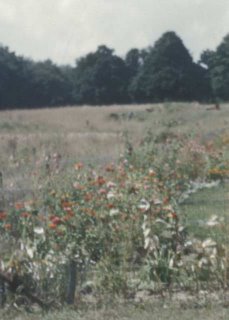 What’s blooming: Sweet alyssum in a pot on the back porch. A bee working a purple aster near the retaining wall suggests the flower is still alive, even though a pinker version of itself.
What’s blooming: Sweet alyssum in a pot on the back porch. A bee working a purple aster near the retaining wall suggests the flower is still alive, even though a pinker version of itself.What’s green in the area: Honeysuckle, cheese, alfilerillo; grasses, including needle grass and June grass; yucca, yew, juniper, arborvitae, piñon, and other pines.
What’s green in my yard: Snapdragons, columbine, roses, bouncing Bess, large flowered soapwort, sweet peas, sweet white clover, salvia, Romanian sage, thrift, rockrose, winecup, hollyhock, red and blue flax, pink and yellow evening primrose, hartwegia, iris, red hot poker, purple mat plant, catmint, California poppy, vinca, tansy, Frikarti and golden hairy asters, Mexican hat, coreopsis, black-eyed Susan, chocolate flower, perky Sue, mums, yarrow.
What’s grey: Snow-in-summer, pinks, buddleia, yarrow, four-winged salt bush.
What’s red: Raspberry, coral bells, pinks, small flowered soapwort, white, coral and blue beardtongues, cholla.
Animal sightings: Squeaky small brown birds; quail were near the wild area down the road where the ivy-leaved morning glories grew earlier; gopher piled up more dirt.
Weather: Clear days, bright stars; furnace runs more in night; no moisture since 15 October.
Weekly update: I recently published a history of my hometown. Before I started I drew up a list of topics that interested me. Naturally, I included gardens. It was only when I did research that I discovered how difficult it is to reconstruct the past.
It would be sheer luck to discover someone’s growing records, and probably impossible to find them for generations. There were traveler’s accounts and developer’s promotions for particular years that described native vegetation to attract settlers. There were also government statistics on crop yields.
Historians turn to nursery catalogs. But, they only indicate what was available, not what was purchased, and definitely not what grew. In my hometown, the seed companies themselves were interesting, because a man who invested in Ferry Seed also invested in the local farm equipment manufacturer. The artifacts of machinery were easier to trace than the seeds.
The better historic record is pictures, which usually can be dated. In Michigan in the nineteenth century, publishers sent artists to offer to do lithographs that were collected into county directories. In my area, the target audience was farmers, which means the pictures of homesteads include the farmyard layout, barns, animals, and at least some indication of the plants since they were indicators of status.
Early photography required light, so many family pictures were taken outdoors. By chance, the background will show the garden or yard. Even my class reunion picture, taken in 1982, showed contemporary methods of cropping corn, because the interior of the Elks lodge was dim.
People like my father, who took pictures of my mother’s first garden in 1948, were rare. Film and developing cost too much to waste on something as insignificant as flowers.
His faded, slightly out-of-focus slides illustrate the difficulties in identifying plants. The zinnias, marigolds and sweet alyssum are easy to identify by shape and color, as are the cosmos and blue morning glories in other pictures. But there’s a foot high plant with white or lavender flowers I don’t recognize.
I can only guess the large, gray blotches in the foreground are the concord grape I know my mother planted in that corner sometime. I can also surmise from a photograph of her foster mother standing in an arbor why my mother wanted that vine.
Pictures can be misleading. They represent a moment in time, and don’t hint my mother never again planted annuals. The next summer she put in shrub roses and perennials. The permanence of the photograph outlasted her interest.
Rather than documenting the existence of specific plants, photographs and lithographs capture the aesthetic of a time. I look now, not at the garden, but at the trees and grasses growing on what was then fallow farmland and consider how much my taste was formed by that landscape, ephemeral as it was. In a few years, the trees were uprooted for more houses, but today I look out my window in New Mexico on an uninterrupted view of golden grasses, broken by junipers, and feel serene.
It wasn’t just me. Many of my schoolmates grew up in town with a desire to return to that historic landscape. Some bought farms; more moved to local lakes. And, I’m sure with the growth of McMansion style developments, others have bought houses like my parents did that bordered on the past. Some always used the excuse of hunting or fishing to disguise the desire to get away.
I gather from friends here that the same attraction to nature, not as a farm and not as a wilderness, but simply as a latent utopia, exists in the Española valley. It’s not tangible childhood memories that drive us to buy seeds or seedlings in May; it’s a connection with our world formed when we were young that persists when we mature.
Notes: Cameron, the history of a Michigan rust belt town from 1830 to 2006, is available at www.xlibris.com/Cameron.html
No comments:
Post a Comment